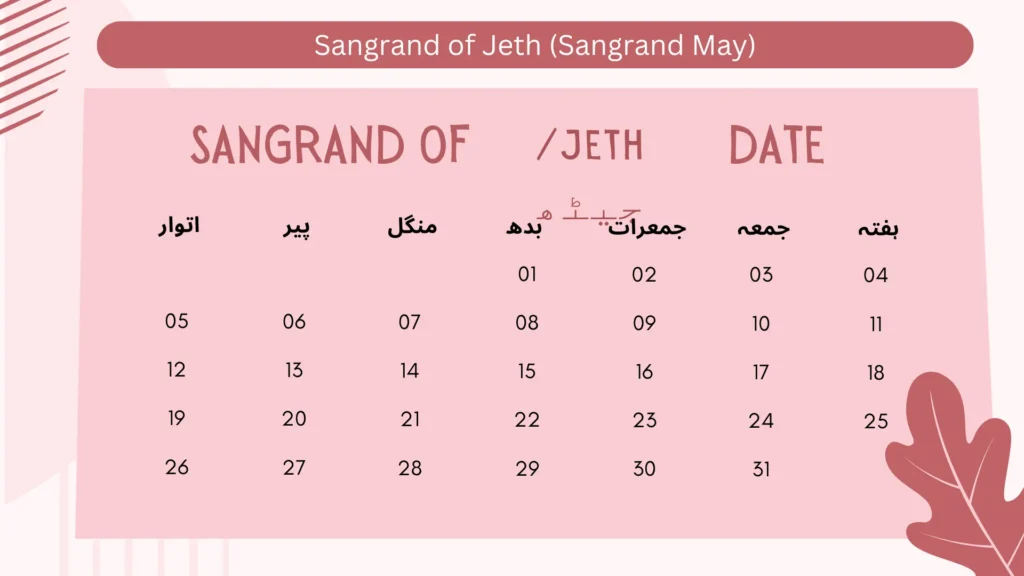Sangrand of Jeth in May According to the Nanakshahi Samvat Calendar
The first day of the month of Jeth is known as the Sangrand of Jeth, which signifies the start of a new month called Jeth. According to the teachings of Sri Guru Nanak Dev Sahib Ji in their Bani of Baramaha and the teachings of Sri Guru Arjan Dev Sahib Ji, our fifth Guru, in their Gurbani of Baramaha, Jeth is recognized as the third month of the year.
You can view the list of all Sangrand dates for each month in the current year. You can also see the English calendar dates for Sangrand in January, February, March, April, June, July, August, September, October, November, and December for the current year.

Significance of Jeth (Sangrand of Jeth)
Previously, we embraced the teachings of Vaisakhi, followed by Jeth. As we enter the third month, we aim to incorporate Guru Sahib Ji’s teachings into our lives.
Teachings for the Month of Jeth (Sangrand of Jeth)
Guru Arjan Dev Sahib Ji blesses us with the teachings:
“Har Jeth Jodanda Lodiye.”
- Har (ਹਰਿ): Refers to Akal Purakh Waheguru, the divine power.
- Jeth (ਜੇਠ): The name of the month.
- Jodanda (ਜੋੜਦਾ): Means to join.
- Lodiye (ਲੋੜੀਏ): Means “we should” (ਚਾਹੀਦਾ ਹੈ).
In this month of Jeth, we are encouraged to join Hari Akal Purakh Waheguru, the most significant and almighty power to whom all creation bows down.
The Power of Akal Purakh Waheguru
Akal Purakh Waheguru is the supreme power before whom all must bow. No matter how powerful someone believes they are, even the mighty must ultimately bow to Waheguru, the almighty power.
Spiritual Growth in Jeth (Sangrand of Jeth)
We are advised to only bow down to Waheguru. Since everyone ultimately bows to Waheguru, we should direct our reverence to the source, the almighty themselves.
The Meaning of Jeth (Sangrand of Jeth)
The term Jeth (ਜੇਠ) also means “eldest” or “greatest.” In Punjabi, Jetha Puttar (ਜੇਠਾ ਪੁੱਤਰ) refers to the eldest child, signifying greatness.
In the spiritual context, we are encouraged to develop Bairag (ਬੈਰਾਗ) (detachment) to join with Waheguru. This requires letting go of worldly attachments and developing love only for Waheguru.
Types of Bairag
There are different ways to categorize Bairag (ਬੈਰਾਗ):
1. Gada Bairag (ਗਦ੍ਹਾ ਬੈਰਾਗ)
- Gada (ਗਦ੍ਹਾ) Means “donkey” in Punjabi.
- This refers to a fleeting form of detachment, where we resolve to focus on Akal Purakh Waheguru but quickly revert to worldly attachments when tempted.
2. Godah Bairag (ਘੋੜਾ ਬੈਰਾਗ)
- Godah (ਘੋੜਾ) Means “horse” in Punjabi.
- A horse can break free from its stable but becomes attached to its master through love. Similarly, we may detach from the world but eventually become re-entrenched in materialism.
3. Shair Bairag (ਸ਼ੇਰ ਬੈਰਾਗ)
- Shair (ਸ਼ੇਰ) Means “lion” in Punjabi.
- The lion’s detachment is permanent. Once free, a lion cannot be recaptured without being killed. This represents the ultimate detachment where love for Waheguru supersedes all worldly attachments.
Embracing Shair Bairag
To develop Shair Bairag, we must accept the inevitability of death and focus solely on our love for Waheguru. This type of Bairag allows us to break free from worldly attachments and maintain our spiritual connection.
Conclusion
During the Sangrand of Jeth, Guru Arjan Dev Sahib Ji advises us to cultivate the most significant type of Bairag, which will enable us to connect with Akal Purakh Waheguru. Let us strive to achieve a lion-like Bairag, where worldly attachments do not disrupt our love for Waheguru, the almighty power to whom all creation bows.
